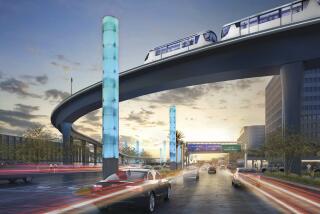Major Overhaul Begins at United’s LAX Terminals
- Share via
The future of LAX is, ha ha, up in the air. Airport commissioners and staffers, deep into drawing up a new long-term master plan to expand the airport, are weighing three different proposals and mulling possible environmental impacts. They hope to choose by June.
But if you’ve flown United Airlines lately--United carries about one in three travelers leaving LAX--the long term may not be your top consideration. You may instead be interested in hearing when someone is going to do something about the tumult in Terminals 6 and 7. And now there is cause for encouragement.
Terminal 7, the last stop on the loop as you circle the LAX car drop-off route, has been getting busier and busier since 1994, when United unveiled Shuttle by United in a bid to boost service to Western cities and steal customers from Southwest Airlines. In many ways, the quiet and not-so-quiet desperation often seen in Terminal 7 is a measure of United’s success: Though Southwest remains strong, United is gaining, and Terminal 7 passenger traffic has grown from 8.7 million in 1993 to 12.9 million in 1996, the last full year for which figures are available.
Those figures include travelers passing through Terminal 7 and also the “Shuttle by United Terminal,” which many travelers think of as Terminal 8, but which LAX considers a satellite of Terminal 7. Additionally, since 1996 United has been substantially boosting its international service through Terminal 6. Overall, United says, its flights from LAX have multiplied from 36 in mid-1994 to 168 now.
But the terminal facilities, which United leases from the City of Los Angeles, haven’t kept up with all that traffic. There have been some improvements: An airport concession-reform effort, begun in 1993 and largely completed last year, has brought Wolfgang Puck pizzas, McDonald’s burgers and other improvements to food and retail offerings, and with the fresh choices, passenger spending throughout LAX has soared. But often, a stroll down crowded Terminal 8, where United’s commuter fliers congregate, is a journey into a hostile, harried territory--just under 100,000 square feet--where no seats are available, an idle telephone is a precious commodity, and everyone seems to have either too much time on hand or not nearly enough.
No more, say United and LAX officials. In December, United began taking the first steps in an 18-month effort to upgrade and expand Terminals 6 and 7. With city help in obtaining financing, the airline is adding seating, augmenting membership club space and redrawing runway traffic patterns, so that planes spend less time waiting for each other to pull away from gates. Among the improvements that should be in place by the summer of 1999:
Shuttle by United Terminal: A 43% increase in floor space for Shuttle by United service, most of it to be achieved by widening the terminal’s long, narrow hallway. Also an additional boarding gate will open, and flight information displays will be moved to more convenient locations.
Terminal 7: New paint, carpeting and furnishings. Remodeled Red Carpet Club. Added restroom space. Relocation of duty-free shop to provide more passenger seating in the center of the terminal.
Terminal 6: A new Red Carpet Club, a new first-class lounge and an “Arrival by United” facility, featuring showers and clothes-pressing, to ease life for the airline’s most prized customers. (New federal inspection facilities were completed in June, ending the unwieldy practice of busing international passengers from their jets to inspection facilities in other terminals.)
In addition, redesigned security will allow passengers to clear a single checkpoint and then move freely among Terminals 6, 7 and 8 without having to submit to repeat screenings. United officials say the security improvements will also mean security personnel will no longer ask travelers to turn on their laptop terminals. United also pledges a baggage-claim area upgrade aimed at making retrieval faster and more efficient. The total tab is expected to reach $200 million.
There’s further encouraging news from at least one other airport quarter: Thirteen years after completion of the Tom Bradley International Terminal just in time for the 1984 Olympics, the city Board of Airport Commissioners in December embraced an $80-million expansion of the facility. The project, expected to take three years, includes expanded baggage-claim and concession areas, as well as increased space for airline club rooms and roomier passenger-processing areas for U.S. Customs, Immigration and Naturalization and the Department of Agriculture.
The effort follows a just-completed $14-million upgrade of concessions, especially food facilities, in that terminal. Commissioners also plan to increase by about 20% the space devoted to international passengers who are passing through LAX without clearing customs. Overall, LAX figures show, the international terminal, designed in 1984 to accommodate 6.8 million passengers yearly, now handles about 13 million.
Meanwhile, American Airlines has been advancing some long-standing plans for major expansion and renovation of its Terminal 4 facilities, which handled 6.3 million passengers in 1996. The airline’s proposal, which has long been in the works, still needs approval from airport officials, and the short-term timetable is unclear. But the American plans call for a face-lift similar to the United project: $200 million in improvements over the next three to five years. Airport officials say smaller improvements at Terminal 4, such as upgrades of water pipes and other utility work, are scheduled to begin in April.
Reynolds travels anonymously at the newspaper’s expense, accepting no special discounts or subsidized trips. He welcomes comments and suggestions, but cannot respond individually to letters and calls. Write Travel Insider, Los Angeles Times, Times Mirror Square, Los Angeles 90053 or e-mail chris.reynolds@latimes.com.
More to Read
Sign up for The Wild
We’ll help you find the best places to hike, bike and run, as well as the perfect silent spots for meditation and yoga.
You may occasionally receive promotional content from the Los Angeles Times.







